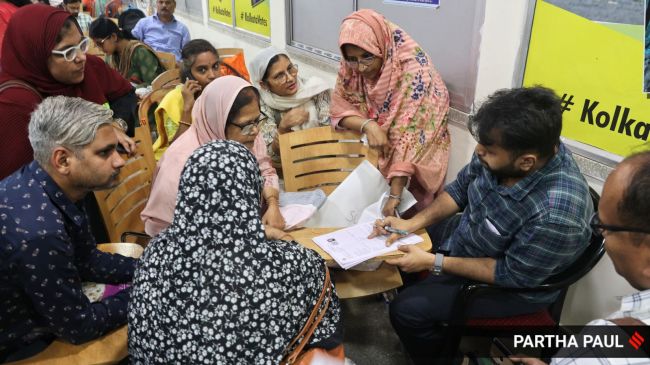Opinion Identity on the line, why SIR is triggering anxiety among voters in Bengal
The fear is not merely about documentation. It is about the systematic narrowing of democratic participation, where the marginalised are pushed out of the political process under bureaucratic pretexts
 Enumeration forms and other materials for SIR being distributed to BLOs at Jessop Building, Kolkata. (Express Photo by Partha Paul)
Enumeration forms and other materials for SIR being distributed to BLOs at Jessop Building, Kolkata. (Express Photo by Partha Paul) The ongoing Special Intensive Revision (SIR) of electoral rolls — an administrative exercise in principle — has spiralled into a social crisis in West Bengal. Two reported suicides linked to fears over missing documents have jolted the state. Chief Minister Mamata Banerjee has led protest marches against the move, calling it “a deliberate attempt to erase identities”. The Left parties have not opposed the SIR outright but have expressed serious reservations to the Election Commission.
Public anxiety has reached staggering proportions. According to official data, in just four days, over one crore people visited the Election Commission’s website to check their names in the 2002 voter list. Long queues now snake around municipal offices, archives, and government departments as people scramble to locate decades-old records.
Why has SIR triggered such panic? After all, a similar process took place in 2002 with far less commotion. Back then, the SIR exercise ran for two years with full cooperation from the then Left Front government. Its aim was to clean up the electoral rolls by removing fake or deceased voters. When the draft list was published on February 4, 2002, nearly 69 lakh names were struck off. Yet, neither the public nor the political establishment reacted with fear.
The difference lies in the process itself. In 2002, citizens had sufficient time to gather their papers. This time, the deadline is barely six weeks — in a state with 7.66 crore voters, compared to 4.58 crore in 2002. Moreover, simple and accessible documents such as ration cards or voter IDs were accepted earlier. There were no self-declaration forms or complex citizenship proofs. Verification was the responsibility of the state and the Election Commission (EC), not of individual citizens. The current SIR reverses this logic, placing the burden of proof on the voter, with 2002 arbitrarily fixed as the “base year”.
The Aadhaar Conundrum
Introduced in 2010 and hailed as “the right of the common citizen,” Aadhaar today covers 1.39 billion Indians. The Centre has spent thousands of crores on the scheme, and Aadhaar is routinely accepted for banking, welfare, and taxation. Yet the Commission insists that while Aadhaar may be shown, it “does not establish citizenship”.
However, none of the 11 documents the Commission deems acceptable — such as utility bills or rent receipts — prove citizenship either. Dismissing Aadhaar on grounds of forgery while accepting other easily falsifiable papers appears arbitrary. Verification, not rejection, should be the guiding principle. EC, after a nudge by the SC, has nevertheless included Aadhar as the 12th document, not to prove citizenship, but as proof of identity.
Official data also refutes the claim that Bengal’s documents are especially prone to forgery. West Bengal accounts for 7.55 per cent of India’s population and holds 7.41 per cent of Aadhaar cards, 7.77 per cent of voter IDs, and 7.46 per cent of ration cards nationally — percentages that align almost perfectly. The narrative of mass forgery, therefore, is statistically untenable.
A Faulty Base Year
The decision to treat 2002 as the base year creates deeper constitutional confusion. If all electoral rolls since 2004 are disregarded, does that not imply that every election and government formed thereafter stand on illegitimate ground? The Commission owes the public a clear explanation.
The human cost of such technicalities is already visible in Bihar, where SIR was recently conducted. Munni Devi, a 50-year-old Dalit woman, found her name missing from the 2025 voter list despite being listed in 2020. She had migrated for work in 2003, lacks her parents’ documents, and cannot retrieve them. Her case is no anomaly — it reflects how the poor, Dalits, and women are disproportionately affected.
In Bihar, gender imbalance in voter lists widened after SIR: In 15 of 38 districts, the female-to-male ratio dropped, with West Champaran recording just 872 women per 1,000 men. Bengal could face a similar pattern. Women’s organisations in Bengal warn that most midday meal and domestic workers —nearly all women — lack the documents demanded.
The structural reasons are well-known: Birth registrations for girls are often neglected; early marriages prevent them from obtaining school certificates; and few own property or bank accounts. Even when documents exist, name mismatches after marriage often lead to disqualification.
The implications are political as well as social. Critics argue that the Commission’s rejection of widely available identity proofs will disproportionately harm the poor, minorities, tribal communities, refugees, and the Matua population. As Trinamool MP Mamatabala Thakur points out, at least 1.5 crore Matuas — a refugee community with long-pending citizenship claims — could be disenfranchised.
The fear, then, is not merely about documentation. It is about the systematic narrowing of democratic participation, where the marginalised are pushed out of the political process under bureaucratic pretexts.
The writer is professor, Department of English and Culture Studies, and director, Centre for Australian Studies, University of Burdwan






